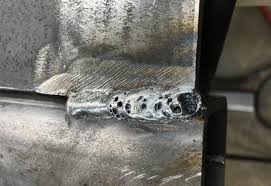Discover What is Porosity in Welding and Its Effect on Architectural Honesty
Discover What is Porosity in Welding and Its Effect on Architectural Honesty
Blog Article
The Scientific Research Behind Porosity: A Comprehensive Guide for Welders and Fabricators
Comprehending the detailed mechanisms behind porosity in welding is important for welders and producers striving for flawless craftsmanship. From the make-up of the base materials to the ins and outs of the welding process itself, a multitude of variables conspire to either worsen or ease the existence of porosity.
Recognizing Porosity in Welding
FIRST SENTENCE:
Evaluation of porosity in welding exposes essential insights right into the honesty and top quality of the weld joint. Porosity, characterized by the existence of cavities or voids within the weld steel, is an usual issue in welding processes. These spaces, otherwise appropriately addressed, can compromise the architectural honesty and mechanical residential or commercial properties of the weld, causing prospective failings in the ended up item.

To discover and quantify porosity, non-destructive screening approaches such as ultrasonic screening or X-ray assessment are typically utilized. These strategies enable the recognition of inner flaws without jeopardizing the integrity of the weld. By analyzing the size, form, and circulation of porosity within a weld, welders can make informed decisions to boost their welding processes and attain sounder weld joints.

Elements Influencing Porosity Formation
The event of porosity in welding is influenced by a myriad of elements, ranging from gas securing effectiveness to the details of welding parameter setups. One critical aspect adding to porosity formation is inadequate gas shielding. When the protecting gas, generally argon or CO2, is not properly covering the weld swimming pool, atmospheric gases like oxygen and nitrogen can infect the molten metal, resulting in porosity. Additionally, the sanitation of the base materials plays a significant role. Contaminants such as corrosion, oil, or moisture can vaporize during welding, producing gas pockets within the weld. Welding criteria, including voltage, present, take a trip rate, and electrode kind, likewise influence porosity development. Utilizing incorrect settings can generate too much spatter or warm input, which in turn can cause porosity. The welding technique utilized, such as gas steel arc welding (GMAW) or shielded steel arc welding (SMAW), can influence porosity development due to variants in heat circulation and gas protection. Comprehending and controlling these variables are crucial for decreasing porosity in welding procedures.
Effects of Porosity on Weld Top Quality
The existence of porosity additionally weakens the weld's resistance to rust, as the caught air or gases within the spaces can respond with the surrounding setting, leading to destruction over time. Furthermore, porosity can hinder the weld's capability to stand up to pressure or impact, further threatening the overall high quality and dependability of the welded framework. In essential applications such as aerospace, automotive, or structural building and constructions, where security and longevity are extremely important, the harmful effects of porosity on weld high quality can have severe effects, emphasizing the relevance of minimizing porosity through appropriate welding methods and treatments.
Techniques to Reduce Porosity
To enhance the high quality of welded joints and guarantee architectural stability, welders and fabricators employ certain techniques focused on decreasing the formation of gaps and tooth cavities within the product during the welding procedure. One effective technique to decrease porosity is to ensure correct material preparation. This consists of detailed cleansing of the base steel to get rid of any kind of contaminants such as oil, grease, or wetness that might add to porosity formation. Furthermore, making use of the ideal welding parameters, such as the proper voltage, current, and take a trip speed, is essential in preventing porosity. Keeping a constant arc size and angle during welding likewise helps in click over here reducing the chance of porosity.

Additionally, picking the appropriate securing gas and preserving correct gas circulation prices read the full info here are essential in minimizing porosity. Utilizing the proper welding technique, such as back-stepping or using a weaving motion, can likewise aid distribute warm evenly and lower the opportunities of porosity formation. Last but not least, making certain correct ventilation in the welding atmosphere to remove any type of potential sources of contamination is essential for attaining porosity-free welds. By carrying out these methods, welders can properly reduce porosity and generate top notch welded joints.

Advanced Solutions for Porosity Control
Applying advanced technologies and cutting-edge methods plays an essential duty in accomplishing premium control over porosity in welding processes. One sophisticated remedy is making use of advanced gas mixtures. Securing gases like helium or a mix of argon and hydrogen can assist reduce porosity by supplying much better arc security and improved gas coverage. In addition, employing sophisticated welding methods such as pulsed MIG welding or changed atmosphere welding can likewise help reduce porosity concerns.
One more advanced option entails making use of advanced welding devices. As an example, using equipment with integrated functions like waveform control and advanced source of power can improve weld high quality and lower porosity threats. In addition, the application of automated welding systems with exact control over specifications can considerably lessen porosity issues.
Moreover, incorporating sophisticated surveillance and examination technologies such as real-time X-ray imaging or automated ultrasonic testing can help in identifying porosity early in the welding procedure, enabling immediate corrective actions. Generally, incorporating these innovative remedies can significantly enhance porosity control and boost the overall top quality of welded elements.
Conclusion
In verdict, understanding the science behind porosity in welding is necessary for welders and producers to create top quality welds. By determining the aspects influencing porosity formation and executing techniques to lessen it, welders can boost the general weld quality. Advanced solutions for porosity control can even more boost the welding process and ensure a solid navigate to these guys and reputable weld. It is essential for welders to constantly educate themselves on porosity and carry out best methods to attain optimal results.
Report this page